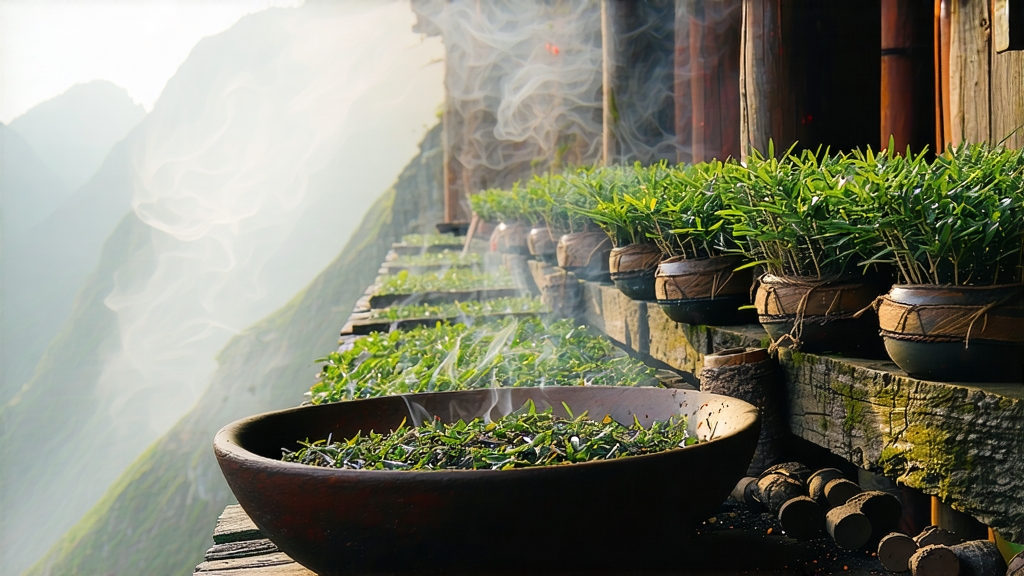
Long before English breakfast tables knew the malty kiss of Assam or the bright snap of Ceylon, a single Chinese leaf sailed out of the Min River estuary and rewrote the global palate. That leaf was Lapsang Souchong, the earliest documented black tea in history and the prototype for every smoky, coppery cup that later carried the label “black.” Today, when sommeliers speak of terroir-driven Chinese hong cha, they still begin their story in the granite gorges of Tongmu, a protected enclave tucked high in the Wuyi Mountains of Fujian Province. Here, at 27° north latitude, subtropical mists rise off the Jiuqu Stream and condense on bushes of the small-leaf Da Bai cultivar, coaxing them into an unusually high ratio of monoterpenes and sugar—precursors to both natural sweetness and an almost perfumed smoke affinity. It is this marriage of plant chemistry and human fire that created Lapsang Souchong, a tea whose very name carries the echo of vanished empires: “Souchong” from the Cantonese siu zung, the fifth and smallest grade of leaf plucked after the spring imperial tribute, and “Lapsang” from the Fuzhou dialect la san, “pine wood smoked.”
Historical records kept by the Dutch East India Company first mention “bohea” (the Min-bei pronunciation of Wuyi) reaching Amsterdam in 1604. The cargo was not the green or oolong that dominated earlier Ming trade, but a fully oxidized, coal-black leaf that brewed a ruby liquor and tolerated months at sea without souring. By the 1660s, Samuel Pepys was writing of “a cup of tee, a China drink,” and Charles II had taxed it heavily, proof that Lapsang Souchong had already become the prestige good that would fund porcelain, silk, and even opium circuits. What the West did not realize was that the smoke note they adored was, in part, a preservation strategy devised by local tea masters to mask mustiness on long voyages. In Tongmu legend, the technique originated during the late Ming chaos, when Qing troop movements forced farmers to rush the drying process; they lit resinous Masson pine to speed the finish, and the accidental flavor proved marketable. Commerce thus turned contingency into signature, and an entire village economy reorganized around the scent of burning pine.
Modern Lapsang Souchong is no longer the commodity-grade, tar-heavy leaf that filled Victorian tins. Climate-controlled withering, charcoal-only firing, and state-mandated geographical indication rules (Tongmu was declared a UNESCO heritage site in 2017) have split the category into two distinct styles. The traditional “smoked” version, exported as “Russian Caravan” or “Taruk” in the Middle East, still withers the leaves on bamboo trays over pinewood embers, then rolls and oxidizes them inside pine-smoke chambers maintained at 28–30 °C for up to eight hours. A final charcoal bake fixes the aroma, yielding long, wiry leaves that smell of smoked apricot and camphor. The newer “unsmoked” or “original aroma” style, prized in China’s domestic gongfu scene, omits the pine phase entirely, relying instead on long withering (18 hours), low-temperature oxidation (22 °C), and a gentle charcoal roast that highlights natural lychee and longan sweetness. Both share the same cultivar and picking standard—two leaves and a bud taken before the Qingming festival—but diverge in chemistry: the smoked version carries guaiacol and 4-methylguaiacol at 3–5 ppm, whereas the unsmoked peaks with hotrienol and geraniol, giving a honeyed, almost Muscat nose.
Crafting either style begins at 4 a.m., when pickers climb 800-year-old stone staircases to plots perched at 1,200 m. The dew-weighted shoots ride down the mountain in wicker baskets lined with fresh banana leaves to prevent bruising. At the workshop, master Chen Shihong—fourth-generation, UNESCO-certified—spreads exactly 3.5 kg per bamboo tray, stacking them in a second-story loft whose shutters are cracked just enough to coax a 60 % moisture loss over six hours. The leaf must arrive at the “soft leather” stage, limp enough to bend without snapping, yet